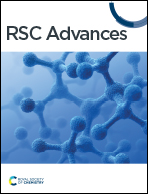2D-Graph of intermolecular interactions predicts radical character of anion–π* type charge-transfer complexes †
Abstract
The molecular orbital (MO) theory is one of the most useful methods to describe the formation of a new chemical bond between two molecules. However, it is less often employed for modelling non-bonded intermolecular interactions because of the small charge-transfer contribution. Here we introduce two simple descriptors, the energy difference (EDA) of the HOMO of an electron donor and the LUMO of an acceptor against such HOMO–LUMO overlap integral (SDA), to show that the MO theory could give a unified charge-transfer picture of both bonding and non-bonding interactions for two molecules. It is found that similar types of interactions tend to be closer to each other in this 2D graph. Notably, in a transition region from strong bonding to single-electron transfer, the interacting molecular pairs appear to present a “hybrid” between chemical bonding and a radical pair, such as anion–π* interactions. It is concluded that the number of nodes in the HOMO and LUMO play a crucial role in determining the bonding character of the molecular pair.



 Please wait while we load your content...
Please wait while we load your content...